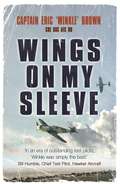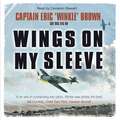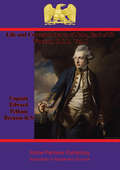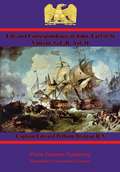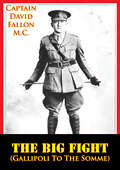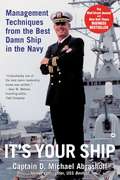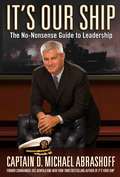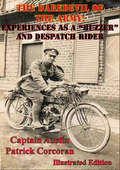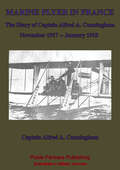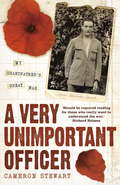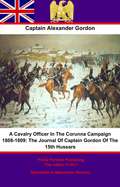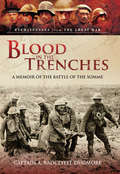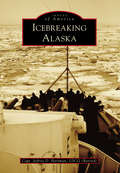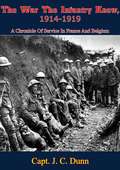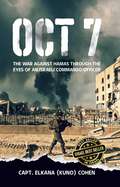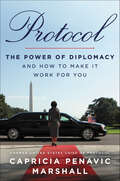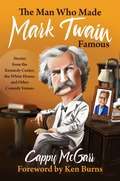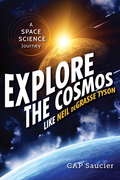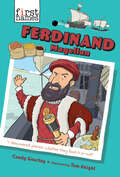- Table View
- List View
Wings on My Sleeve: The World's Greatest Test Pilot tells his story
by Captain Eric BrownThe autobiography of one of the greatest pilots in history.In 1939 Eric Brown was on a University of Edinburgh exchange course in Germany, and the first he knew of the war was when the Gestapo came to arrest him. They released him, not realising he was a pilot in the RAF volunteer reserve: and the rest is history. Eric Brown joined the Fleet Air Arm and went on to be the greatest test pilot in history, flying more different aircraft types than anyone else. During his lifetime he made a record-breaking 2,407 aircraft carrier landings and survived eleven plane crashes. One of Britain's few German-speaking airmen, he went to Germany in 1945 to test the Nazi jets, interviewing (among others) Hermann Goering and Hanna Reitsch. He flew the suicidally dangerous Me 163 rocket plane, and tested the first British jets. WINGS ON MY SLEEVE is 'Winkle' Brown's incredible story.
Wings on My Sleeve: The World's Greatest Test Pilot tells his story
by Captain Eric BrownThe autobiography of one of the greatest pilots in history.In 1939 Eric Brown was on a University of Edinburgh exchange course in Germany, and the first he knew of the war was when the Gestapo came to arrest him. They released him, not realising he was a pilot in the RAF volunteer reserve: and the rest is history. Eric Brown joined the Fleet Air Arm and went on to be the greatest test pilot in history, flying more different aircraft types than anyone else. During his lifetime he made a record-breaking 2,407 aircraft carrier landings and survived eleven plane crashes. One of Britain's few German-speaking airmen, he went to Germany in 1945 to test the Nazi jets, interviewing (among others) Hermann Goering and Hanna Reitsch. He flew the suicidally dangerous Me 163 rocket plane, and tested the first British jets. WINGS ON MY SLEEVE is 'Winkle' Brown's incredible story.(p) 2016 Orion Publishing Group
Life and Correspondence of John, Earl of St Vincent, G.C.B. Vol. I: Admiral of the Fleet &C. &C. & C. (Life and Correspondence of John, Earl of St Vincent, G.C.B. #1)
by Captain Edward Pelham Brenton R.N.This ebook is purpose built and is proof-read and re-type set from the original to provide an outstanding experience of reflowing text for an ebook reader. Earl St. Vincent was not only an excellent administrator, a fine sailor and undaunted defender of the Royal Navy. He was also eclipsed in the tomes of history by his more famous protégé, Lord Nelson. Sir John Jervis had served for many years with distinction before Nelson's birth; defending Jamaica from privateers and pirates, distinguishing himself during the Seven Years war and War of American Independence. This two-volume biography by Captain Brenton, a contemporary (albeit junior) of both naval heroes, goes some way to fixing the void in the record of Earl St Vincent. The biography includes much of the original documentation and letters of the period when the invasion of the British isles was a real possibility as the French and Spanish turned from enemies to allies and joined their naval might together. At that time Sir John Jervis was in command of squadrons in the Channel, as he had been beforehand in the Mediterrean, enforcing a blockade that strangled the commerce of Spain and France. During those times that ships escaped port, Jervis and his subordinates hunted them without mercy, the most striking example being the battle of St. Vincent. Although outnumbered by his Spanish opponents, Sir John led fifteen of his ships on. The following anecdote is told of the initial contact before the battle: "There are eight sail of the line, Sir John" "Very well, sir" "There are twenty sail of the line, Sir John" "Very well, sir" "There are twenty five sail of the line, Sir John" "Very well, sir" "There are twenty seven sail of the line, Sir John" "Enough, sir, no more of that; the die is cast, and if there are fifty sail I will go through them" His entry in the Oxford Dictionary of National Biography states that -- "His importance lies in his being the organizer of victories; the creator of well-equipped, highly efficient fleets; and in training a school of officers as professional, energetic, and devoted to the service as himself." An excellent and detailed read. Title - Life and Correspondence of John, Earl of St Vincent, G.C.B. Vol. I Sub-Title - Admiral of the Fleet &C. &C. & C. Series Name - Life and Correspondence of John, Earl of St Vincent, G.C.B. Series Number -- 1 Author -- Captain Edward Pelham Brenton R.N. (1770-1844) Text taken, whole and complete, from the edition published in two volumes 1838, London, by H. Colbourn. Original - viii and 500 pages. Illustrations - one portrait.
Life and Correspondence of John, Earl of St Vincent, G.C.B. Vol. I: Admiral of the Fleet &C. &C. & C. (Life and Correspondence of John, Earl of St Vincent, G.C.B. #2)
by Captain Edward Pelham Brenton R.N.This ebook is purpose built and is proof-read and re-type set from the original to provide an outstanding experience of reflowing text for an ebook reader. Earl St. Vincent was not only an excellent administrator, a fine sailor and undaunted defender of the Royal Navy. He was also eclipsed in the tomes of history by his more famous protégé, Lord Nelson. Sir John Jervis had served for many years with distinction before Nelson's birth; defending Jamaica from privateers and pirates, distinguishing himself during the Seven Years war and War of American Independence. This two-volume biography by Captain Brenton, a contemporary (albeit junior) of both naval heroes, goes some way to fixing the void in the record of Earl St Vincent. The biography includes much of the original documentation and letters of the period when the invasion of the British isles was a real possibility as the French and Spanish turned from enemies to allies and joined their naval might together. At that time Sir John Jervis was in command of squadrons in the Channel, as he had been beforehand in the Mediterrean, enforcing a blockade that strangled the commerce of Spain and France. During those times that ships escaped port, Jervis and his subordinates hunted them without mercy, the most striking example being the battle of St. Vincent. Although outnumbered by his Spanish opponents, Sir John led fifteen of his ships on. The following anecdote is told of the initial contact before the battle: "There are eight sail of the line, Sir John" "Very well, sir" "There are twenty sail of the line, Sir John" "Very well, sir" "There are twenty five sail of the line, Sir John" "Very well, sir" "There are twenty seven sail of the line, Sir John" "Enough, sir, no more of that; the die is cast, and if there are fifty sail I will go through them" His entry in the Oxford Dictionary of National Biography states that -- "His importance lies in his being the organizer of victories; the creator of well-equipped, highly efficient fleets; and in training a school of officers as professional, energetic, and devoted to the service as himself." An excellent and detailed read. Title - Life and Correspondence of John, Earl of St Vincent, G.C.B. Vol. II Sub-Title - Admiral of the Fleet &C. &C. & C. Series Name - Life and Correspondence of John, Earl of St Vincent, G.C.B. Series Number -- 2 Author -- Captain Edward Pelham Brenton R.N. (1770-1844) Text taken, whole and complete, from the edition published in two volumes 1838, London, by H. Colbourn. Original - xii and 418 pages. Illustrations - one map.
The Big Fight (Gallipoli To The Somme) [Illustrated Edition]
by Captain David Fallon M.C.Includes the First World War Illustrations Pack - 73 battle plans and diagrams and 198 photos"Gallipoli and the Western Front to the end of 1916, as experienced by the author who served with the Australians and 1/Buckingham Bn of the O&B LIThis book is an account of the author's battlefield experiences at Gallipoli and on the Western Front. Fallon was a pre-war regular (Northumberland Fusiliers) who, when war broke out, was a staff sergeant instructor at the Australian Royal Military College in Duntroon. Transferred in some unexplained fashion to the Australian army he took part in the Gallipoli landings on 25 April 1915, which he describes in gory detail, as he does the rest of the fighting till he was evacuated in December. Back in the British army he was commisioned into the Buckingham Battalion (TF) of the O & B LI (145th Bde/48th Division) with which he fought on the Western Front till badly wounded at the end of 1916. He seems to go out of his way to make his descriptions of the fighting as bloody as possible, and as for the Germans, he has a chapter entitled "Hun Beastliness" in which he makes unbelievable statements such as the two examples which follow: It was the nude body of the Mother Superior. She had been nailed to the door. She had been crucified. In the ruins we brought out the bodies of four nuns, unspeakably mutilated. Their bodies had been stabbed and slashed each more than a hundred times. They had gone to martyrdom resisting incredible brutes. They had fought hard, the blond hair of their assassins clutched in their dead hands. And again, at Wytschaete: Above the wreck of the skyline trench bayonets stuck up, and on them were the severed heads, with horrible smiles under their English caps, of twenty of my men. Referring to German soldiers he writes: They hate the bayonet. The cold steel is not for Hans. Shades of Dad's Army, Lcpl Jones and "They don't like it up 'em"."-Print ed.
It's Your Ship: Management Techniques from the Best Damn Ship in the Navy
by Captain D. Michael AbrashoffThe legendary New York Times bestselling tale of top-down change for anyone trying to navigate today's uncertain business seas. When Captain Abrashoff took over as commander of USS Benfold, it was like a business that had all the latest technology but only some of the productivity. Knowing that responsibility for improving performance rested with him, he realized he had to improve his own leadership skills before he could improve his ship. Within months, he created a crew of confident and inspired problem-solvers eager to take the initiative and responsibility for their actions. The slogan on board became "It's your ship," and Benfold was soon recognized far and wide as a model of naval efficiency. How did Abrashoff do it? Against the backdrop of today's United States Navy, Abrashoff shares his secrets of successful management including: See the ship through the eyes of the crew: By soliciting a sailor's suggestions, Abrashoff drastically reduced tedious chores that provided little additional value. Communicate, communicate, communicate: The more Abrashoff communicated the plan, the better the crew's performance. His crew eventually started calling him "Megaphone Mike," since they heard from him so often. Create discipline by focusing on purpose: Discipline skyrocketed when Abrashoff's crew believed that what they were doing was important. Listen aggressively: After learning that many sailors wanted to use the GI Bill, Abrashoff brought a test official aboard the ship-and held the SATs forty miles off the Iraqi coast. From achieving amazing cost savings to winning the highest gunnery score in the Pacific Fleet, Captain Abrashoff's extraordinary campaign sent shock waves through the U.S. Navy. It can help you change the course of your ship, no matter where your business battles are fought.
It's Our Ship: The No-Nonsense Guide to Leadership
by Captain D. AbrashoffCaptain D. Michael Abrashoff, legendary commander of the USS Benfold, continues in the same vein of his bestselling book IT'S YOUR SHIP with the knowledge he's gained from his speaking to and advising some of the top business minds in the world. The story of Captain Abrashoff and his command of USS Benfold has become legendary inside and outside the Navy. By governing his ship with his unique management techniques, Abrashoff turned the Benfold into a model of naval efficiency, with amazing cost savings, the highest gunnery score in the Pacific Fleet, and a highly motivated and top performing crew. In IT'S YOUR SHIP, he first demonstrated how to bring his successful management techniques from the ship to the boardroom. Now, in his newest book IT'S OUR SHIP, in the same rugged, can-do voice, Abrashoff will focus on the leadership, motivational, and management insights and tips that he has learned from his last six years of addressing business and corporate audiences. Abrashoff's timely advice will be eminently prescriptive, and will feature anecdotes and insights from leaders of businesses large and small and from public and non-profit sectors.
The Daredevil Of The Army; Experiences As A “Buzzer” And Despatch Rider [Illustrated Edition]
by Captain Austin Patrick CorcoranIncludes the First World War Illustrations Pack - 73 battle plans and diagrams and 198 photos"A bikers war-compellingly recounted"The highly dangerous task of the aide-de-camp was often to carry urgent despatches with essential calls to action across the field of battle. The young men chosen for the job were invariably dashing, brave and prepared to take risks to achieve their objectives. They were, of course, always expert horsemen. The age of the military horseman had not quite come to a close at the time of the First World War, but-as with most forms of progress-he was sharing duties with that which would eventually replace him, the machines of the new age. Now there was a another breed of 'daredevil,' though necessarily 'cut from the same cloth.' The motorcycle despatch riders were a new service created in an age of innovation. All were so called 'amateur' soldiers though immediately at least ranked corporal so that they could, by British Army convention, address officers directly. These were invariably intelligent, accomplished young men drawn from the professions or universities. Their creed was the same as that of their horse mounted predecessors-the messages they carried had to get through and to deliver them motorcyclists often had to outpace charging Uhlans. Many of them ended their careers tangled among the wreckage of their 'bikes.' The author of this book has written a thrilling first hand account of his experiences riding military motorcycles along the front lines during the early stages of the First World War. Later as an officer he took command of a unit of 'buzzers,' whose job it was to maintain telephone links. A highly entertaining book and thoroughly recommended to all those interested in motorcycles, motorcycling and the Great War in Europe."-Print ed.
Marine Flyer In France — The Diary Of Captain Alfred A. Cunningham, November 1917 - January 1918
by Captain Alfred Austell CunninghamDuring November and December 1917, Captain Alfred A. Cunningham, the first Marine Corps aviator, travelling under orders from Major General Commandant George Barnett, toured the battlefronts and flying fields of France to observe Allied air operations and training.The diary, kept in tiny, neat handwriting in a small pocket notebook, begins on 3 November 1917 with Cunningham's sailing from New York on board the S. S. St. Paul. After a description of a rough winter passage through the North Atlantic U-boat zone, the entries record the confusion, inconveniences, and hardships of wartime London and Paris and contain repeated expressions of homesickness, along with sometimes acid comment on the French people and culture. His tour of British and French airfields culminated with his flying a number of the different aircraft then in service, even flying himself with French airmen on combat missions in December 1917.
A Very Unimportant Officer
by Alexander Stewart Captain Alexander Stewart Cameron StewartRediscovered after 80 years gathering dust on a family bookshelf and first brought to public attention on BBC Radio 4’s Today Programme, A VERY UNIMPORTANT OFFICER is a detailed and intimate account of the experience of Captain Stewart, an ordinary officer in the front line in France and Flanders throughout 1916 and 1917.Recruited to The Cameronians (Scottish Rifles) in 1915 at the age of 33, Captain Stewart went 'over the top' many times, outliving 'so many better men', as he says with typical humility.Through his vivid testimony we learn of the mud ('more like thick slime'), the flies and the difficulties of suffering dysentry while on horseback. In one memorable passage he describes engaging the enemy while smoking a pipe - an episode for which he was awarded the Military Cross.Yet through the chaos and horror of the trenches, Captain Stewart reflects with compassion on the fears and immense courage of the men under his command.Newly edited by his grandson, Cameron Stewart, A VERY UNIMPORTANT OFFICER gives us a fascinating insight into the horrors and absurdities of trench life.
A Cavalry Officer In The Corunna Campaign 1808-1809: The Journal Of Captain Gordon Of The 15th Hussars
by Captain Alexander GordonThis ebook is purpose built and is proof-read and re-type set from the original to provide an outstanding experience of reflowing text for an ebook reader. Captain Gordon led a troop of the 15th Hussars during the first of the British army's campaigns into Spain, commanded by Sir John Moore. Unearthed and published many years after it was written by the esteemed Regimental historian Colonel Wylly, his diary bears testimony to the events of the retreat to Corunna. Gordon writes of his adventures with verve, wit and in some places a little venom when talking of his erstwhile commander Moore; he is fulsome in his description of the Portuguese and Spanish people to whom the British had come to aid. For example when relating the qualities of a local wine he could "only compare the taste of it to a mixture of vinegar and ink" On military matters he is no great respecter of rank, and distributes blame and praise where he believes they should be rightly apportioned. He gives a great first-hand account of the famed skirmish of Sahagun, to which he believes started a moral ascendancy of the British cavalry over their French counterparts. Despite some defective equipment and, as Gordon attributes it, dilatory conduct by the commander, he reaches Corunna unlike a number of his comrades and fellow country-men. A fine read, which despite its format as a journal retains some pace, it gives a great view of the retreat from an expert military eye. Text taken, whole and complete from the 1913 edition, John Murray, London Original -238 pages Author - Captain Alexander Gordon (1781-1872) Editor - Colonel Harold Carmichael Wylly (1858-1932) Illustrations - 1 portrait, 2 plans, 1 map not included because of size [A3] Linked TOC
Blood in the Trenches: A Memoir of the Battle of the Somme (Eyewitnesses from The Great War Series)
by Captain A. Dugmore<p>Written by Captain A. Radclyffe Dugmore of the King's Own Light Infantry, this personal memoir provides an excellent account of the Great War up to the Battle of the Somme. A wide ranging and perceptive relation of events, Radclyffe Dugmore's pedigree as a professional writer shines through. In 1914, Radclyffe Dugmore travelled to Belgium as a civilian observer where he was wounded before spending a brief time in German captivity. These experiences gained Radclyffe Dugmore a highly unusual viewpoint for the opening battles of the war, that of a civilian, and later as a participant on the front lines of the Somme.Originally published under the title When The Somme Ran Red in 1918, Radclyffe Dugmore's memoir has sadly been long out of print. Yet what the author modestly described as 'Being a very egotistical account of my own personal experiences and observations from the early days of the war in Belgium to the Great Battle of the Somme in July, 1916' proves to be anything but that, consisting of a fascinating and rare account, sympathetically dedicated to the memory of the officers and men of the King's Own Yorkshire Light Infantry who fell in the Battle of the Somme.<p> <p>This new re-print of Radclyffe Dugmore's classic volume is a worthy addition to the primary source literature of the Great War, and casts new light on the experiences of the brave men who saw the terror of the Battle of the Somme first hand.<p>
On the Border with Mackenzie: or, Winning West Texas
by Capt. R. G. CarterWhen it was first published in 1935, On the Border with Mackenzie, or Winning West Texas from the Comanches quickly became known as the most complete account of the Indian Wars on the Texas frontier during the 1870s, and remains one of the most exhaustive histories ever written by an actual participant in the Texas Indian Wars.The author, Capt. Robert G. Carter, a Union Army veteran and West Point graduate, was appointed in 1870 to serve as second lieutenant in the Fourth United States Cavalry stationed at Fort Concho, Texas. He was awarded the Medal of Honor in 1900 for his gallantry in action against the Indians occurring on October 10, 1871, during the battle of Blanco Canyon. Led by Col. Ranald Slidell Mackenzie, the Fourth Cavalry moved its headquarters to Fort Richardson, Texas, in 1871 where they soon became one of the most effective units on the western frontier. Among the battles and skirmishes they participated in were the Warren wagon train raid of 1871; the Kicking Bird pursuit of 1871; the Remolino fight of 1873; the Red River War of 1874-75; and the Black Hills War of 1876.“…a splendid contribution to the early frontier history of West Texas…a story filled with humor and pathos, tragedies and triumphs, hunger and thirst, war and adventure.”—L. F. Sheffy“…[Carter] pulls no punches in this outspoken narrative, and the reader always knows where he stands.”—John H. Jenkins, Texas Basic Books“…essential to any study of the Indian Wars of the Southern Plains.”—Charles Robinson, Foreword
Bai
by Capt. NarendraMemoires in the form of a diary written in 1967 by Vimlabai Edited and translated into Gujarati from original Marathi by Capt. Narendra.
Icebreaking Alaska
by Capt. Jeffrey Hartman UscgThe Arctic is a place of great challenges and great rewards. A century ago, it was whale oil; today, it is motor oil. The increasing open water in the warmer months is attracting cruise ships to tour the Arctic. Significant offshore oil and natural gas deposits are of great interest to an oil-dependent economy. But the history of the Arctic is full of surprises for the unwary and the unprepared, despite native peoples having managed to live there for thousands of years. Oil spills or maritime emergencies can--and do--arise a long way off from assistance. Legendary Arctic storms are, if anything, becoming more intense and dangerous. All this is in an area inaccessible by roads or by sea except for icebreakers the majority of the year. It is of extreme interest to the US Coast Guard, charged with protecting seafarers, enforcing laws, and facilitating commerce.
The War The Infantry Knew, 1914-1919: A Chronicle Of Service In France And Belgium
by Capt. J. C. DunnMemoirs of British medical officer J. C. Dunn during World War I: "The first duty of a battalion medical officer in War is to discourage the evasion of duty...not seldom against one's better feelings, sometimes to the temporary hurt of the individual, but justice to all other men as well as discipline demands it.""Sometimes, through word of mouth and shared enthusiasm, a secret book becomes famous. The War the Infantry Knew is one of them. Published privately in a limited edition of five hundred copies in 1938, it gained a reputation as an outstanding account of an infantry battalion's experience on the Western Front."--Daily Telegraph"I have been waiting for a long time for someone to republish this classic. It is one of the most interesting and revealing books of its type and is a genuinely truthful and fascinating picture of the war as it was for the infantry"--John Keegan'A remarkably coherent narrative of the battalion's experiences in diary form...a moving historical record which deserves to be added to the select list of outstanding accounts of the First World War"--Times Literary Supplement"A magnificent tour de force, the length of three ordinary books."--London Review of Books
OCT 7: The War Against Hamas Through the Eyes of an Israeli Commando Officer
by Capt. Elkana CohenA shocking, detailed account of present-day war as told by an Israeli commando officerThe persona of the Israeli officer who strives for absolute victory is well reflected in Capt. Elkana Cohen's new book —Prime Minister Benjamin Netanyahu Elkana Cohen tells the story of thousands of young reservists who dropped everything on 10/7 and went out to defend our nation —Naftali Bennett, thirteenth Prime Minister of Israel On the morning of October 7, 2023, Israelis awoke to a harrowing reality. Not only were hundreds of rockets being launched from Gaza into Israeli population centers, but the security border between Gaza and Israel had also been breached by several thousand Hamas terrorists. Carnage, not seen since the Second World War, ensued. Elkana Cohen, Captain of an Elite Commando Unit was called, along with thousands of other reservists, to prepare for war. One that will have to ensure nothing less than Israel&’s survival. In notebooks he found on the ground in the streets of Gaza, Cohen began writing a diary. Every day, he candidly documented the sights of the war. From an honest, precise and fluid first-person perspective, Cohen presents the feeling and story of the war from the eyes of the heroes who were there: the dust, the sweat, the brotherhood, the longing, and the awful smell of death and destruction. Cohen&’s writing poignantly describes his relationships with his fellow comrades, the mass arrests of terrorists, the homes of Hamas members, the story of the fallen soldiers, and the desperate hope to bring the hundreds of Israeli hostages home. Why did the prisoner from Jabaliya reveal to IDF soldiers that he had millions of shekels hidden in his house? What's on the Hamas terrorists&’ GoPro cameras? Why did the author feel sick every time he ate meat? How did the soldiers behave when the terrorist they were following went up to the roof of a building with a baby in his arms? OCT 7 is not only the story of one Israeli officer, but it is also the narrative of an entire nation. A nation that stepped up without a moment's hesitation to face an existential challenge with a sense of purpose and mission.
Protocol: The Power of Diplomacy and How to Make It Work for You
by Capricia Penavic MarshallPresident Obama’s former United States chief of protocol looks at why diplomacy and etiquette matter—and how they can help you in everyday life.In her roles as chief of protocol for President Barack Obama and social secretary to President Bill Clinton and First Lady Hillary Clinton, Capricia Penavic Marshall not only bore witness to history, but she also facilitated it. From curating rooms to have an intended impact to knowing which cultural gestures earned trust, her detailed measures were superpower influences that laid the groundwork for successful diplomacy between leaders and tilted the advantage, always, in her team’s favor. Sharing unvarnished anecdotes of harrowing near misses and exhilarating triumphs, Marshall offers the master class in soft power.Praise for Protocol“A trusted friend and a trusted colleague. I can’t imagine anyone who has been a greater public servant.” —Hillary Clinton“Working with Capricia during the Obama administration was nothing short of wonderful! Her guiding hand and innovative methods laid the foundation for our successful diplomacy on the world stage.” —Valerie Jarrett, former senior advisor to Barack Obama and author of Finding My Voice“Fascinating. . . . An informative and often charming primer on a little-known—but vital—government post.” —Kirkus Reviews
The Man Who Made Mark Twain Famous: Stories from the Kennedy Center, the White House, and Other Comedy Venues
by Cappy McGarrIn The Man Who Made Mark Twain Famous, Cappy McGarr shares how he became an Emmy-nominated co-creator/executive producer of the Kennedy Center Mark Twain Prize for American Humor, and got involved in national politics—all with charming southern style and a self-deprecating sense of humor.For decades, Cappy McGarr has been in the room where it happens. With The Man Who Made Mark Twain Famous, he&’d like to invite you into that room, complete with his color commentary on the other folks inside. For the first time in print, Cappy reveals how the Mark Twain Prize was conceived, how it changed venues and networks, and even how it almost wasn&’t renewed after a controversial first outing with Richard Pryor. From there, Cappy pulls back the curtain for a behind-the-scenes look at over two decades of the Mark Twain Prize, sharing his take on the Kennedy Center&’s tributes to Pryor, Jonathan Winters, Carl Reiner, Whoopi Goldberg, Bob Newhart, Lily Tomlin, Lorne Michaels, Steve Martin, Neil Simon, Billy Crystal, George Carlin, Bill Cosby, Tina Fey, Will Ferrell, Ellen DeGeneres, Carol Burnett, Jay Leno, Eddie Murphy, Bill Murray, David Letterman, Julia Louis-Dreyfus, and Dave Chappelle. Cappy also gives the inside scoop on several shows he produced from the East Room of the White House, including the Gershwin Prize for Popular Song. Plus, he tells tales from his involvement in national politics—including encounters with the likes of President Lyndon B. Johnson, Senate Majority Leader Tom Daschle, Governor Ann Richards, President George W. Bush, President Barack Obama, and many others. &“Reading Cappy&’s book is not unlike sitting down to dinner with him and listening to the stories he has picked up from decades of rubbing elbows with political leaders and comedians alike. There are historic set pieces. There are laughs and howls and chuckles and chortles.&” —Ken Burns Cappy is donating all of his proceeds from this book to the Kennedy Center Arts Education Programs.
Explore the Cosmos like Neil deGrasse Tyson
by Cap SaucierThis introduction to space science for children uses the story of Neil deGrasse Tyson's life and career to frame the journey.Catch the thrill of the cosmos and space science through the life of Neil deGrasse Tyson--the popular astrophysicist, science communicator, and host of FOX-TV's Cosmos: A Spacetime Odyssey. In language neither too simple nor overly technical, author CAP Saucier interweaves up-to-date information about the universe and the science of astrophysics with a biographical portrait of the famous astrophysicist. Quotes from Tyson appear throughout each chapter, personalizing the science. Illustrated with striking images from the Hubble Space Telescope, the story of one man's successful life in space science may inspire kids to follow a similar path. As Tyson makes clear, there is still much to do for future space scientists: diverting asteroids, unraveling the mystery of dark matter, finding life elsewhere in the universe, and more!From the Trade Paperback edition.
Explore the Cosmos like Neil deGrasse Tyson
by Cap SaucierThis introduction to space science for children uses the story of Neil deGrasse Tyson's life and career to frame the journey.Catch the thrill of the cosmos and space science through the life of Neil deGrasse Tyson--the popular astrophysicist, science communicator, and host of FOX-TV's Cosmos: A Spacetime Odyssey. In language neither too simple nor overly technical, author CAP Saucier interweaves up-to-date information about the universe and the science of astrophysics with a biographical portrait of the famous astrophysicist. Quotes from Tyson appear throughout each chapter, personalizing the science. Illustrated with striking images from the Hubble Space Telescope, the story of one man's successful life in space science may inspire kids to follow a similar path. As Tyson makes clear, there is still much to do for future space scientists: diverting asteroids, unraveling the mystery of dark matter, finding life elsewhere in the universe, and more!From the Trade Paperback edition.
The Stars Beckoned: Edward White's Amazing Walk In Space
by Candy WellinsA lyrical picture book biography of Edward White, the first American to walk in space--and an ode to the beauty and wonder of the stars that brought him there.Edward Whiteloved the night,lived where stars were big and bright.The evening sky--so wide, so high.Made him wonder. Made him sigh.Edward White was the first American astronaut to walk in space. But before his spacewalk, he was just a boy who loved the stars. As he grew up, he would look up at the night sky in wonder--he knew that, one day, he would visit the stars themselves. In this touching and poignant picture book biography, we see how Edward's passion for the stars shaped the course of his life, and how he came to realize, even in the depths of space, what was ultimately most important to him--his family.With backmatter containing photos and more information on Edward's life, Candy Wellins and Courtney Dawson deliver a book that is as much a feast for readers' eyes as the stars were for Edward's. Praise for The Stars Beckoned:"The right stuff for children with the stars in their eyes." --Kirkus Reviews "An introduction to a space pioneer that&’s ideal for the youngest nonfiction readers." --Publishers Weekly
Running Down a Dream: A Memoir
by Candy PalmaterA powerful, often funny, always inspiring memoir from a beloved comedian, professional orator, actor, entertainer, gone all too soon.Candy Palmater loved to connect with people. She lived for the stage, her effervescent presence on television and radio ignited and inspired audiences, touching them with her warm, often spicy humour as well as her positive message about love and kindness. And she always believed that it is never too late to pursue our dreams and that we should never allow others to negatively influence our life’s desires.Candy described herself as a queer Mi’kmaw lawyer-turned-comic raised by bikers in rural New Brunswick and on the surface, she met with enormous success – on leaving government and the practice of law, she started a career as a stand-up comedian, which led to starring in five successful seasons of her own national TV show, hosting many radio shows and co-guest hosting CTV’s The Social, and landing a recurring role on a hot new sitcom in her fifties. But she is the first to tell you she made all kinds of mistakes and experienced all kinds of failure along the way. Running Down a Dream is Candy’s story, in her own words, of the highs, the lows, the moments of doubt, the turning points when she listened to her gut and tuned out all the people saying no. It’s also a tribute to her family and the love that always bolstered her, despite their own hard times. She shares her stories to inspire us to embrace our failures and to believe in ourselves. And most importantly, Running Down a Dream is a call to love ourselves for who we are.The world lost Candy in late 2021, and yet she left us with this gift -- a memoir and a message that will inspire us for years to come.
Ferdinand Magellan (The First Names Series)
by Candy GourlayAn illustrated biography of the famous explorer with “plenty of engaging action scenes and historical facts” (School Library Journal). Before he led the first expedition to circumnavigate the Earth, Ferdinand Magellan (1480–1521) was a Portuguese noble who loved the sea. A skilled sailor, he led a number of voyages and is known for his incredible navigation skills. Over the course of his sailing career, he faced terrible storms and mutinies but always managed to get his crew home safely. He set off with his crew to circle the globe—a trip that no other ship had ever completed. Though Magellan died in combat in the Philippines before he could complete the voyage, his ship went on to complete the first circumnavigation of the world, and he is still known as one of the greatest explorers. However, as historians today note, many of the places that Magellan “discovered” already had people living there, and his fame is one rooted in colonialism. Ferdinand Magellan tackles the legacy—both good and bad—of this famous explorer.First Names is a highly illustrated nonfiction series that puts young readers on a first-name basis with some of the most incredible people in history and of today!
Candy Darling: Memoirs of an Andy Warhol Superstar
by Candy DarlingA look into what moved Andy Warhol&’s greatest muse Located at 33 Union Square West in the heart of New York City&’s pulsing downtown scene, Andy Warhol&’s Factory was an artistic anomaly. Not simply a painter&’s studio, it was the center of Warhol&’s assembly-line production of films, books, art, and the groundbreaking Interview magazine. Although Warhol&’s first Factory on East 47th Street was known for its space-age silver interior, the Union Square Factory became the heart, brain, eyes, and soul of all things Warhol—and was, famously, the site of the assassination attempt that nearly took his life. It also produced a subculture of Factory denizens known as superstars, a collection of talented and ambitious misfits, the most glamorous and provocative of whom was the transgender pioneer Candy Darling. Born James Slattery in Queens in 1944 and raised on Long Island, the author began developing a female identity as a young child. Carefully imitating the sirens of Hollywood&’s golden age, young Jimmy had, by his early twenties, transformed into Candy, embodying the essence of silver-screen femininity, and in the process became her true self. Warhol, who found the whole dizzying package irresistible, cast Candy in his films Flesh and Women in Revolt and turned her into the superstar she was born to be. In her writing, Darling provides an illuminating look at what it was like to be transgender at a time when the gay rights movement was coming into its own. Blessed with a candor, wit, and style that inspired not only Warhol, but Tennessee Williams, Lou Reed, and Robert Mapplethorpe, Darling made an indelible mark on American culture during one of its most revolutionary eras. These memoirs depict a talented and tragic heroine who was taken away from us far too soon.
